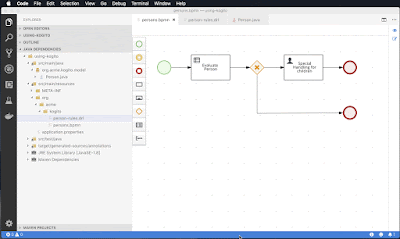After writing up an introduction to our Kogito effort, it seems people are interested in hearing a little but more about the name, where it comes from, what the logo means, and (what seems to be the most important question) how to pronounce Kogito? Yes, there even was a JIRA issue [KOGITO-284] opened to address this issue!
First, the name Kogito itself comes from:
"Cogito, ergo sum"
a Latin philosophical proposition by René Descartes usually translated into English as "I think, therefore I am" [Wikipedia]. So Kogito simply means "I think", and refers to how users are encoding business knowledge using various formats (processes, rules, constraints, etc.). The 'c' was replaced with a 'k' as a reference to Kubernetes, our target cloud platform, and Kie where the k stands for knowledge.
"Kogito, ergo automate" therefore means, "I think, therefore I automate" and refers to the use of business automation to encode business knowledge.
Our logo is a reference to Odin, the Norse God that gave up an eye for wisdom [Wikipedia].
“According to mythology, Odin ventured to the mystical Well of Urd at the base of the world-tree that holds the cosmos together. The well was guarded by Mimir, a shadowy being who becomes all knowing by drinking the magical waters. Odin asked for a drink and Mimir replied that Odin must sacrifice an eye for a drink. Odin gouged out his own eye, dropped it into the well, and was allowed to drink from the waters of cosmic knowledge.”
Finally, how do I pronounce Kogito? Since it comes from the Latin phrase "Cogito, ergo sum", the obvious first question could be, how do I pronounce that? As it turns out, not an easy question to answer, but in the end the Italians in our team proclaimed this to be the only correct pronunciation:
[ˈkoː.d͡ʒi.to]
so that's with the emphasis on the first syllable, and the 'g' pronounced as 'dji', or (if you're not skilled in phonetic language at all like me ;)) just listen to the video below:
Some good news though, because it seems no mortal person is able to consistently pronounce it this way, other pronunciations are completely fine too!






